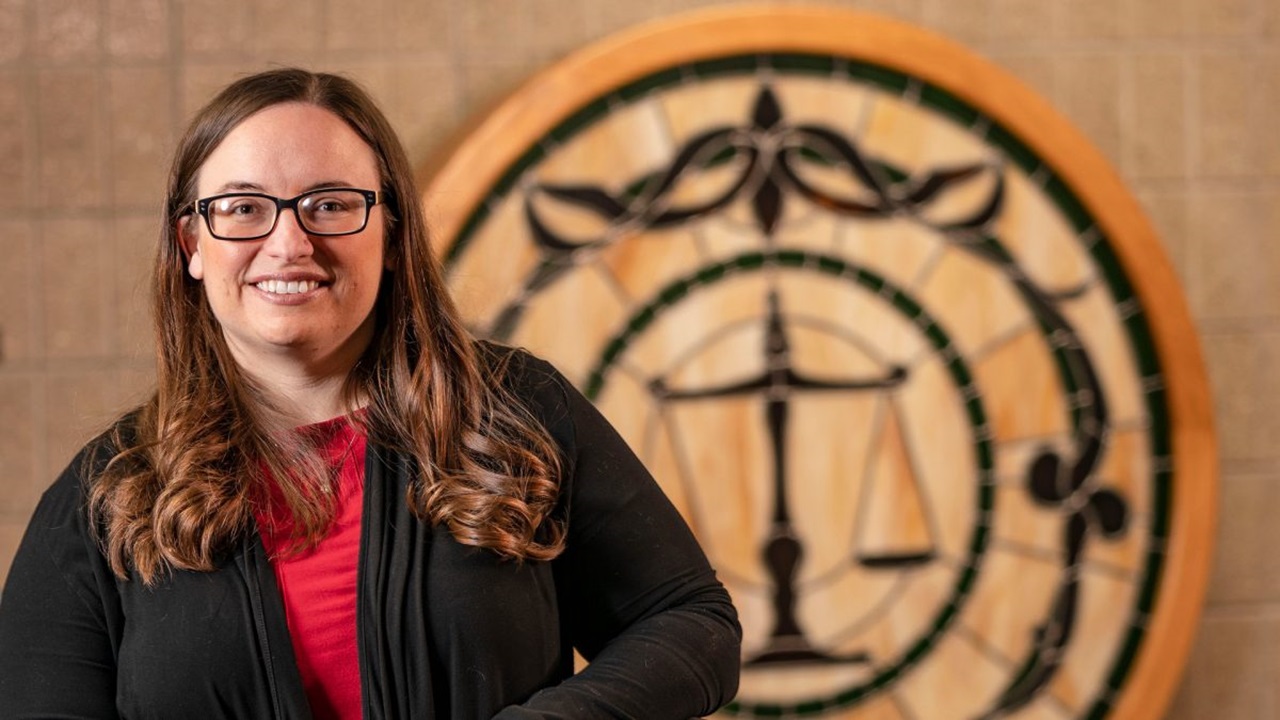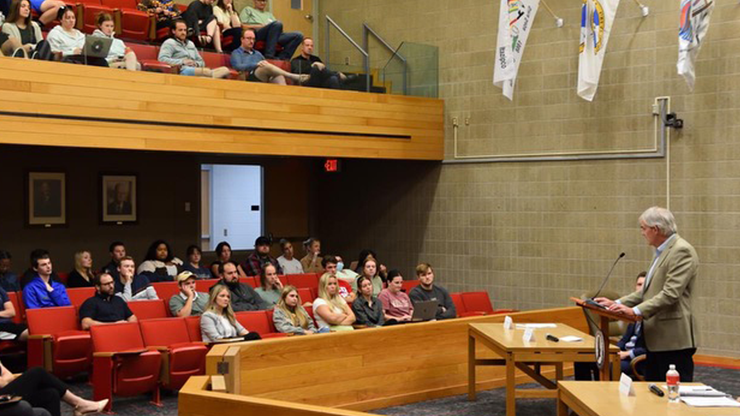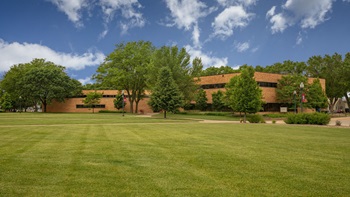A Champion for Rural Law

Having grown up in Yankton, South Dakota, Hannah Haksgaard knows people in rural areas face unique challenges concerning the law that people in urban areas do not. Yet, many don’t realize that, and there is a lack of scholarship and attention on rural places, spaces and the people that live there. Additionally, there is a shortage of attorneys who practice rural law and have law firms in small communities. Without available attorneys, citizens in rural counties don’t have access to justice. Haksgaard hopes to enlighten people of the issues of rural South Dakota as well as highlight the good the state is doing to combat the rural lawyer shortage in her recent article that was published by the Harvard Law & Policy Review in 2018.
In the article, Haksgaard and her colleagues survey each of the states in which they work–South Dakota, California, Georgia, Minnesota, Maine and Wisconsin–to gather data. The authors then provide a comprehensive look at how each state handles the rural lawyer shortage. They discuss themes, propose solutions and they draw from all the scholarship that has been written about other states they didn’t include in the article.
“We know there is a rural lawyer shortage, but we don’t have national data on it,” said Haksgaard. “The article is a piecemeal document that tries to figure out what’s going on with different states and how states are combatting the problem.”
Though the states all have the same problem, South Dakota is the only state that has a funded incentive program in place to help new attorneys get established in rural practice, and it is doing well.
“I was invited to contribute to the article because South Dakota is unique in the situation,” Haksgaard said. “South Dakota has Project Rural Practice, a paid incentive program to help new attorneys, and we are the only state that has a successful initiative.”
In 2011, South Dakota’s state bar developed Project Rural Practice, a project aimed at recruiting rural attorneys and managed by South Dakota’s Unified Judicial System. In 2013, the South Dakota legislature approved the Recruitment Assistance Pilot Program to provide qualifying attorneys an incentive payment in return for five continuous years of practice in an eligible rural county with a population of 10,000 or fewer. The funding comes from three sources: 50 percent from the state, 15 percent from the state bar and 35 percent from the county where the lawyer is placed.
“The idea is that the five years should get a new lawyer started in a rural practice, and after, they should be self-sustaining,” Haksgaard said. “The hope is that the five years will get people through the worst part of their career financially when they have to find clients.” Currently, there are 32 Project Rural Practice positions—10 of which are still open for new lawyers. Of the 22 practicing attorneys, 18 are USD law graduates.
“We’ve seen success in that the lawyers participating in Project Rural Practice have almost all stayed and have been financially successful,” said Haksgaard. “One of them has even been able to take on several associate attorneys.”
Haksgaard found that the USD School of Law is ahead of the curve because it helps students prepare for the transition to rural practice.
“We wrote about what law schools should be doing better to help bridge the gap of getting students to take up rural jobs, and basically what we talked about schools needing to do, USD School of Law is already doing,” Haksgaard said.
A Different Take
Haksgaard attended Berkeley Law after receiving her Bachelor of Arts degree in political science and gender and women’s studies from the University of Kentucky. During a seminar at law school, Haksgaard presented one of her papers that focused on rural inheritance and surprised her classmates. They had never thought about the rural issues Haksgaard wrote about, and they were dismissive toward rural people and the legal problems they face. Their reactions and the lack of scholarship devoted to rural legal issues encouraged Haksgaard to continue writing about rural areas.
“For me, it was a natural expectation that people were writing about rural issues because I grew up in Yankton, South Dakota,” Haksgaard said. “Once I got out in the world, I found that it is actually a really neglected area and one that I hope I can make a difference in with my writing.”
In her other publications, Haksgaard focuses on modern issues in areas such as family law, gender and property. Most lean heavily on historical facts and information.
“If you write about the law, you have to write about history,” said Haksgaard. “We have a common law that develops over time, and in a way, every legal scholar writes about history. We’re talking about how the present influences the future.”
Shortage of Rural Lawyers
Haksgaard calls attention to the fact that rural America is typically characterized as one homogenous region and its citizens and challenges are overgeneralized. Policies, too, overgeneralize and fail to address the issues rural America faces. Rural Americans suffer disproportionately from poverty, the opioid epidemic and educational deficits and environmental degradation, to name a few, but there are not enough lawyers or other forms of legal assistance available to support the legal service needs of individuals in rural America.
"I see my role in writing about Project Rural Practice as amplifying the good that South Dakota is doing, and I want to make it broadly known, said Haksgaard."
"I see my role in writing about Project Rural Practice as amplifying the good that South Dakota is doing, and I want to make it broadly known, said Haksgaard."
One of the reasons for that is often that law schools around the country tend to focus on urban or suburban issues because of the location of the school and where law professors have worked. Very few explicitly look at rural places. Because law students aren’t taught about rural issues, they rarely pursue a career in a rural area.
“We’re also worried about baby boomers that practiced in rural areas,” Haksgaard said. “As the baby boomers retire, we have an issue because we have decades of people not going into rural practice, and we need to remedy that because there are not as many people going in as there are people retiring.”
South Dakota Success
South Dakota leads as the only state that offers an incentive program for new attorneys who practice in rural communities. As Project Rural Practice is still in its initial stages, Haksgaard is interested to see the long-term effects of the successful program.
“We have measured success right now, but we don’t know the long-term measure,” she said. “In five to 10 years, someone needs to reflect on how Project Rural Practice changed the rural lawyer shortage in South Dakota. In the future, I hope to write a big piece that looks how the first group of Project Rural Practice lawyers is doing.”
Other states have tried to do what South Dakota has done but have not achieved success. Haksgaard said that other states won’t provide funding because they’re under the assumption that rural practices will not be profitable.
“I hope that other states realize how successful Project Rural Practice has been at a relatively low cost,” said Haksgaard. “I see my role in writing about Project Rural Practice as amplifying the good that South Dakota is doing, and I want to make it broadly known.”
“I hope that other states realize how successful Project Rural Practice has been at a relatively low cost,” said Haksgaard. “I see my role in writing about Project Rural Practice as amplifying the good that South Dakota is doing, and I want to make it broadly known.”
One of the solutions Haksgaard proposes to help remedy the shortage is to prepare law students to practice in a rural setting. The USD School of Law excels in this because of its location, its history of sending attorneys to rural areas and because it offers several student opportunities that prepare its students for careers in rural law.
“There are a lot of things future rural lawyers at USD should do, such as take the Law Office Management course or participate in trial teams,” Haksgaard said. “These are things that set students apart because they are ready to leave and practice right away. Taking advantage of the learning opportunities at USD is critical.”
Though South Dakota is at the forefront with Project Rural Practice, there is still room to improve access to justice.
“I think where South Dakota is behind is the legal aid money in rural areas, but people everywhere want more legal aid money, so it is not unique to rural areas,” Haksgaard said. “We do conclude in the article that there is a nationwide disproportional amount of legal aid funding going to urban areas compared to rural.”
South Dakota Law Review Advisor
Haksgaard’s extensive writing portfolio has prepared her for the role as advisor of the South Dakota Law Review. Haksgaard took over as advisor at the beginning of the 2018 fall semester.
“Professor Haksgaard understands the type of institutional and faculty support a student-run publication needs to thrive,” said Thad Titze, the 2019-20 Law Review editor-in-chief.
As a previous student editor of the Berkeley Journal of Gender, Law & Justice, Haksgaard looks forward to providing similar learning experiences for USD students.
“Participating in a student-run journal is one of the best learning experiences a law student can have,” Haksgaard said. “I greatly benefitted from being a student editor.”
“My favorite thing about teaching at USD law is being able to contribute to the legal community of my home state in a meaningful way. I love South Dakota, and I hope that through my scholarship and my teaching, I am able to benefit the legal community in this state.”
As advisor, Haksgaard guides and supports the seven members of the editorial board as well as the current staff writers.
“She is both an excellent teacher and an excellent scholar,” said Titze. “Excellence in both areas means she really cares about students as well as the quality of the Law Review’s content. Students really respect her as a professor and mentor.”
“Publishing law review articles is an important and enjoyable part of my job as a professor, and I greatly enjoy getting to participate in both sides of the publication process—from the author side with my own work and from the publication side with the South Dakota Law Review,” Haksgaard noted.
Since she joined the law school faculty in 2016, Haksgaard has served as an advisor of two student groups, the Family Law & Child Advocacy group and the R.D. Hurd Volunteer Law School Society. “I have thoroughly enjoyed getting to know students and having the ability to work one-on-one with many students,” Haksgaard said.
“My favorite thing about teaching at USD law is being able to contribute to the legal community of my home state in a meaningful way. I love South Dakota, and I hope that through my scholarship and my teaching, I am able to benefit the legal community in this state.”
For more information about Project Rural Practice, visit the State Bar of South Dakota or the Unified Judicial System websites.



